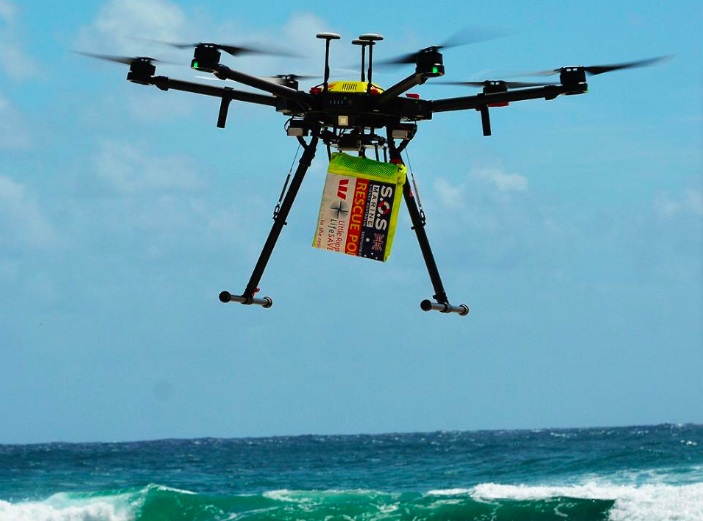3 Ways Drones Are Proving More Useful Than Ever Imagined
They’re spotting sharks before they strike, delivering medical supplies to isolated regions and getting pipelines and bridges repaired before they fail.

It was a December day, early summer in Australia. Two busloads of schoolchildren had just splashed into the water at Secret Harbour, a beach on the Indian Ocean, when a drone swooped down from the sky and issued a deafening order to clear the water. The drone, equipped with vision-recognition technology, had identified a 10-foot shark swimming in a zigzag pattern just 100 yards from the beach.
Half a world away, in Rwanda, delivery drones ferry life-saving packages of blood and vaccines across the mountains of Central Africa to remote medical clinics. The flying machines automatically text the clinics when they’re two minutes away. Upon arrival, they drop their deliveries from 40 feet up and then promptly turn around and zip back to their home base, or “nest.”
Meanwhile, in the U.S., expanding legions of drones monitor pipelines and bridges for signs of corrosion to head off catastrophic accidents.
As drones grow stronger, faster and smarter, new iterations seem to be emerging month by month — each one designed and trained for a different vocation. They’re going way beyond their initial work in the military or meteorology, and plowing into delivery and logistics, the energy industry and farming. Much of this growth is being fueled by artificial intelligence. AI enables the newest generation of drones to not only perceive data, but also to interpret and act on it.
Michal Mazur, who heads Drone-Powered Solutions for PriceWaterhouseCoopers, predicts that business services involving drones will soar above $100 billion by the early 2020s. “They’re getting smarter every month,” he says.
Scanning the sea for danger
This deepening intelligence powers the Ripper Group’s shark-spotting drones in Australia. Chief Operating Officer Ben Trollope says the Westpac Little Rippers stream video in real time. Functioning like a visual search engine, the software scans vast miles of ocean for the tell-tale shape of a shark. The machine-learning program has been trained on millions of photos of sharks and other shapes in the sea. The challenge now is perceiving the sharks at ever-greater depths and in murky water. Sometimes, Trollope says, the system still confuses a small whale for a shark. But every mistake sharpens its focus.
Westpac Little Rippers patrol the skies over dozens of Australia’s beaches. When they spot a shark, they call out an unmissable 130-decibel warning and direct swimmers away from danger. Ripper Group also makes larger drones that can drop life rafts and emergency supplies to distressed swimmers or boaters.
Health care for all of Rwanda
The drones used in Rwanda, produced by California robotics company Zipline, look more like airplanes than helicopters. The fixed-wing design adds strength to help power the vessels through storms. They have a round-trip range of up to 90 miles.
In less than two years, Zipline has delivered 4,000 shipments in Rwanda — one-third of them life-saving, according to the UPS Foundation, which has invested $2 million in the venture. In coming months, a second nest will enable the drone network to cover the entire Central African country, reaching 400 health clinics. Because normal impediments don’t hinder their movements, they’re fast, and can be used at a moment’s notice, drones offer flexible and nimble new methods of delivery. Joe Ruiz, director of UPS Foundation’s Humanitarian & Resilience Program, foresees a growing role for drones in aid and rescue, from natural disasters to medical emergencies. “Think of organ transplants,” he says.
A boon to infrastructure repair
Autonomous drones are already flying over (and under) bridges and along pipelines, pinpointing areas that are corroded or have loose struts — and scheduling the needed repairs. This constant machine surveillance could soon replace the old and inefficient way of spotting trouble: having teams of human inspectors occasionally fly over in a helicopter.
Just for fun
Drones are also starting to make their mark in at live events, from the Olympics in South Korea to a spectacular show at this year’s Coachella Valley Music & Arts Festival in Indio, Calif. During the nighttime outdoor performances of ODESZA, the GRAMMY-nominated electronic music team of Clayton Knight and Harrison Mills, HP and Intel teamed up to send 420 Shooting Star drones zipping through the night sky above the crowds, the first time these drones flew over a live music performance. “We were honored to be a part of it,” the duo said.
Watch Intel’s HP-powered Shooting Stars drone light show at Coachella.

